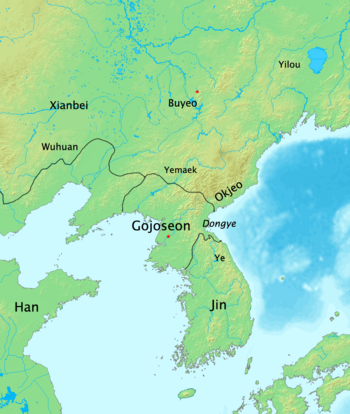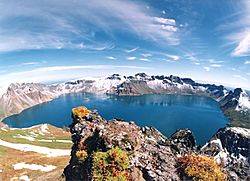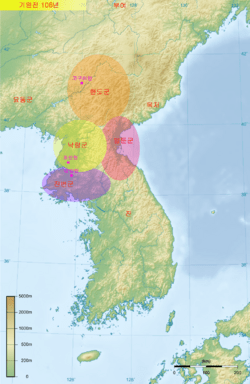Gojoseon facts for kids
Quick facts for kids
Gojoseon
|
|||||||||||
|---|---|---|---|---|---|---|---|---|---|---|---|
| ?–108 BC | |||||||||||

Gojoseon in 108 BC
|
|||||||||||
| Capital | Wanggeom City | ||||||||||
| Common languages | Ye-Maek (Koreanic), Classical Chinese (literary) |
||||||||||
| Religion | Shamanism | ||||||||||
| Government | Monarchy | ||||||||||
| King | |||||||||||
|
• 2333 BC? – ?
|
Dangun (first) | ||||||||||
|
• 1126 BC? – 1082 BC?
|
Gija | ||||||||||
|
• 232 BC – 220 BC
|
Bu | ||||||||||
| Historical era | Ancient | ||||||||||
|
• Established
|
? | ||||||||||
|
• Coup by Wi Man
|
194 BC | ||||||||||
| 109–108 BC | |||||||||||
|
• Fall of Wanggeom City
|
108 BC | ||||||||||
|
|||||||||||
| Today part of | North Korea South Korea China |
||||||||||
| Korean name | |
| Hangul | |
|---|---|
| Hanja | |
| Revised Romanization | Gojoseon |
| McCune–Reischauer | Kojosŏn |
| IPA | [ko.dʑo.sʌn] |
| Alternative Korean name | |
| Hangul | |
| Hanja | |
| Revised Romanization | Joseon |
| McCune–Reischauer | Chosŏn |
| IPA | [tɕo.sʌn] |
Gojoseon (Korean: 고조선; Hanja: 古朝鮮; RR: Gojoseon) was the very first kingdom on the Korean Peninsula. It is also sometimes called Joseon. The word Go means "ancient" and helps us tell it apart from the later Joseon dynasty that started in 1392 CE.
According to old Korean stories, a legendary founder named Dangun started Gojoseon in 2333 BCE. He was said to be the son of a heavenly prince and a bear-woman. Even though Dangun is a mythical figure, his story is very important for Korean identity. Today, both North Korea and South Korea celebrate the founding of Gojoseon as their National Foundation Day.
Some historical writings say that later, around the 12th century BCE, a wise man named Jizi (also known as Gija) came to the northern part of the Korean Peninsula. He was from the royal family of the Shang dynasty in China. He supposedly founded a kingdom called Gija Joseon. However, historians still debate whether Gija Joseon truly existed.
In 194 BCE, a refugee from China named Wi Man took over the rule of Gojoseon. He then established a new period known as Wiman Joseon. The capital of Gojoseon was Wanggeom, which is thought to be modern Pyongyang.
The Han dynasty of China, led by Emperor Wu, invaded and conquered Wiman Joseon in 108 BC. The Han dynasty then set up four areas to control the land that used to be Gojoseon. Later, around 313 CE, the kingdom of Goguryeo took control of this area.
Contents
Founding Stories
There are three main stories about how Gojoseon began. They involve Dangun, Gija, or Wi Man.
The Dangun Story
The most famous story is about Dangun. It was written down in a 13th-century Korean book called Samguk Yusa. The story says that Dangun was born from a heavenly prince named Hwanung and a bear who turned into a woman named Ungnyeo.
According to the legend, Hwanung, the son of the Lord of Heaven, came down to Baekdu Mountain. There, a bear and a tiger wanted to become human. Hwanung told them to stay in a cave for 100 days, eating only mugwort and garlic. The tiger gave up, but the bear succeeded and became a beautiful woman. Hwanung married her, and they had a son, Dangun.
Historians believe the Dangun story might be a mix of different historical events. It could show how two groups of people, one who worshipped the sky and another who worshipped bears, came together to form Gojoseon. Dangun is said to have founded Gojoseon around 2333 BC.
The Gija Story
Another story involves Gija, a person from the Chinese Shang dynasty. He supposedly came to the Korean peninsula in 1122 BC when the Shang dynasty fell. He then founded Gija Joseon. This story is mentioned in early Chinese records.
In the past, many Koreans believed that Dangun gave Korea its people and basic culture. They thought Gija brought higher culture and made Korea a more developed civilization. However, many modern experts question if Gija Joseon really existed. They point out that some very old Chinese texts that mention Gija do not say he moved to Gojoseon.
The Wi Man Story
Wi Man was a military officer from China. He came to the northern Korean peninsula in 195 BCE. He then took over the rule from King Jun and became king of Gojoseon. He made Wanggeom-seong his capital. This event started a new period called Wiman Joseon.
How Gojoseon Grew
Early records mention Gojoseon as a region near Bohai Bay that traded with the Chinese state of Qi. By the 4th century BCE, Gojoseon had become a strong state with a clear political system. It grew by joining with other nearby city-states, either through alliances or by military conquest. This created a large group of political areas between the Taedong and Liao rivers.
The leader of Gojoseon began to be called "king" around the same time as the leaders of the Chinese state of Yan. Gojoseon was a prosperous Bronze Age civilization. It had a complex society, including skilled horse-riding warriors.
Around 300 BCE, Gojoseon lost a lot of its western land after a war with the Yan state. However, this shows that Gojoseon was strong enough to fight a major war and still survive. It is believed that Gojoseon moved its capital to the Pyongyang region around this time.
Wiman Joseon and Its Fall
In 195 BCE, King Jun of Gojoseon put Wi Man, a refugee from China, in charge of guarding the border. But in 194 BC, Wi Man rebelled and took the throne. King Jun fled to the Jin state in the south.
In 109 BCE, Emperor Wu of Han invaded Gojoseon. The war started because Wi Man's grandson, King Ugeo, refused to let ambassadors from the Jin state pass through his land to reach the Han dynasty. King Ugeo's son, Prince Wi Jang, escorted the ambassador back. But near the Han border, the ambassador killed Prince Wi Jang and lied to Emperor Wu, saying he had won a battle against Joseon. Emperor Wu believed him and made him a military commander. King Ugeo was very angry and attacked the Han area, killing the commander.
Emperor Wu then sent two armies, one by land and one by sea, to attack Gojoseon. The armies struggled to work together and suffered many losses. Finally, in 108 BCE, the capital city of Wanggeom fell. The Han dynasty took control of Gojoseon's lands and set up Four Commanderies of Han there.
Gojoseon slowly broke apart in the 1st century BCE. Many new states grew from its former territory, like Buyeo, Okjeo, and Dongye.
Culture and Daily Life
Around 2000 BCE, people in Gojoseon developed a new style of pottery. They lived in settled communities and farmed. Archaeologists have found rectangular huts and large dolmen burial sites. They also found unique Korean bronze daggers and mirrors.
Mumun Pottery
During the Mumun pottery period (1500 – 300 BCE), people started using plain, coarse pottery. This might have been because new groups of people moved to Korea from Manchuria and Siberia. This pottery was thicker and came in more shapes, showing that people were getting better at making it. This time is sometimes called the "Korean Bronze Age," but bronze items were still quite rare until the 7th century BCE.
Rice farming was common in southern Korea and Manchuria between 1900 BCE and 200 CE.
Bronze Tools
The Bronze Age in Korea is thought to have started around 1000 BCE. The bronze culture in Korea was influenced by areas like Liaoning and Manchuria, but it also had its own unique styles, especially for special objects used in rituals.
By the 7th century BCE, a strong Bronze Age culture was present in Korea. Korean bronze items have more zinc than those from nearby areas. Bronze objects found in burial sites include swords, spears, daggers, small bells, and mirrors with geometric patterns.
Gojoseon's growth seems connected to its use of bronze technology. A special type of bronze sword, called a "mandolin-shaped dagger" (비파형동검), is found in Gojoseon areas. This unique dagger shape is different from Chinese swords and suggests the areas where Gojoseon had influence.
Tombs
Dolmen Tombs
Large stone tombs called dolmens appeared in Korea and Manchuria between 2000 BCE and 400 BCE. By 900 BCE, burial practices became more complex, showing that society was becoming more organized with different social classes. Korea has more dolmen tombs than any other part of East Asia. Other new types of burials included stone cists (underground stone-lined chambers) and earthenware jar coffins. The bronze objects, pottery, and jade found in these tombs show that they were for important people.
Around the 6th century BCE, shiny red pottery appeared in dolmen tombs and in everyday bowls and cups.
Other Types of Tombs
In 1964, two tombs, Gangsang and Nusang, were found in the Liaodong peninsula. These are thought to be burial mounds for important people from Gojoseon.
Iron Culture
Around 300 BCE, people in Korea started using iron technology, which came from the Yan state in China. By the 2nd century BCE, iron was being made locally in the southern part of the peninsula. Chinese writings say that iron from the lower Nakdong River in the southeast was highly valued throughout Korea and Japan.
Poetry
An old Chinese book called Gogeumju (written around the 3rd century CE) says that a poem called Gonghuyin (or Gongmudohaga) came from Gojoseon. The poem goes like this:
公無渡河 "Don't cross the river, my love."
公竟渡河 "My love eventually crossed the river."
墮河而死 "Now that my love is drowned,"
當奈公何 "There's nothing that I can do."
After Gojoseon
Many smaller states and groups formed from the remains of Gojoseon, including Goguryeo, the Buyeo kingdom, Okjeo, and Dongye. Three of the Chinese commanderies fell to local resistance within a few decades. However, the last one, Nakrang, remained an important trading and cultural center until Goguryeo destroyed it in 313 CE.
Jun of Gojoseon, the king who was overthrown by Wi Man, is said to have fled to the Jin state in the southern Korean Peninsula. The Jin state later developed into the Samhan confederacies: Mahan, Jinhan, and Byeonhan. King Jun ruled Mahan, which was later taken over by Baekje.
Eventually, Goguryeo, Baekje, and Silla grew into the powerful Three Kingdoms of Korea. By around the 4th century, these three kingdoms controlled the entire peninsula.
See also
 In Spanish: Gojoseon para niños
In Spanish: Gojoseon para niños
- Names of Korea
- History of Korea
- Three Confederate States of Gojoseon



